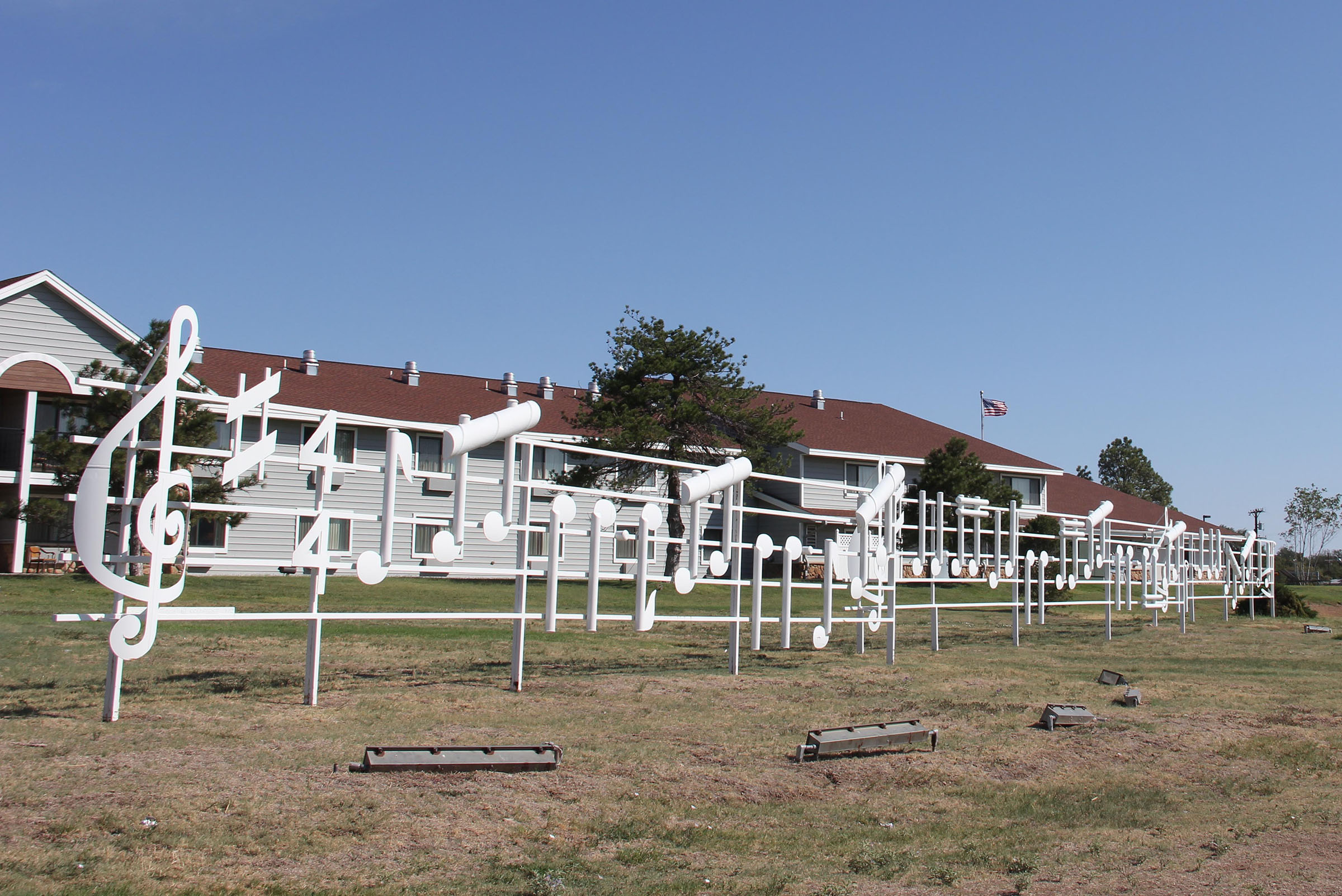
Photo courtesy Woody Guthrie Folk Music Center.
Woody Guthrie is known as an Okie, but he spent eight formative years in the Texas Panhandle town of Pampa. It was there, about 60 miles northeast of Amarillo, that Guthrie learned the guitar, started writing songs, married a local girl, and experienced the “Great Dust Storm” of 1935 that inspired a song and shaped his artistic empathy for the dispossessed.
When you come into the Gray County seat, as a 17-year-old Guthrie did from Okemah, Oklahoma, in 1929, you’re greeted with the notes of the introduction to his most famous song, “This Land Is Your Land,” on a 142-foot-long facsimile of the sheet music. Some fans have brought their guitars and played along to the accurate notation in carbon steel.
Built in 1992 by welder Rusty Neef, on a commission from Pampa’s Foundation of Outdoor Art, the 10-foot-tall installation just off State Highway 70 (1000 Coronado Drive) used to light up at night in red, white, and blue. But in recent years, vandals have smashed the floodlights.
“Woody Guthrie remains a controversial figure in Pampa,” says Michael Sinks, director of the town’s Woody Guthrie Folk Music Center.
Protest singers are not very popular in a county that voted 80 percent Republican in the 2020 election and has been a conservative stronghold since 1952. Guthrie, who died in 1967, has also been knocked for “family values,” after leaving his wife, Mary Jennings, and their three children in Pampa when he joined the westward migration of Dust Bowl refugees in 1937. The family was eventually reunited in California, but divorce came in 1942.
“They say he was a communist and an atheist,” Sinks continues, “but he was just pro-union. He was out for working people to organize and have a better life.”
Guthrie fans from all over the world make pilgrimages to the town where he wrote his first standard, “So Long, It’s Been Good to Know You,” in 1935 and have their pictures taken in front of the “This Land” sculpture.
The Woody Guthrie Folk Music Center is located downtown in the former Harris Drug Store at 320 Cuyler Street, where Guthrie once worked. “Our only Woody Guthrie artifact is the building,” says Sinks, who curates the museum with copies of photos, lyrics, and letters. “He worked here for five years [between 1929 and 1934] and found his first guitar in the back room.”
Woody’s uncle Jeff Guthrie, the town’s deputy sheriff, gave him some lessons, as did a Black man they called “Spider Fingers” because of the way he plucked the strings. It wasn’t long before Woody started his first band, the Corn Cob Trio. The history is all there in the shop where Guthrie sometimes sold bootleg whiskey from under the counter.
Another must-stop into Pampa’s time of Woody is the Coney Island Cafe, opened by Greek immigrants in 1933 and still going strong. Bob Wills from nearby Turkey also ate at the Coney. “Their chili dogs are legendary,” Sinks says. As is the singer-songwriter who championed the have-nots during the Great Depression and was the prime inspiration for Bob Dylan.
Woody Guthrie died in 1967 at age 55 of Huntington’s disease, which slowly shuts down the nervous system, causing him to be hospitalized the final 12 years of his life. The hereditary condition also took his mother and two of his daughters, though it was not passed to son Arlo, who followed in his father’s musical footsteps. The Oct. 3, 1992, unveiling of the “This Land Is Your Land” music notes sculpture came on the 25th anniversary of Woody Guthrie’s death.
The installation “has been around so long that it’s kinda been taken for granted here in town,” Sinks says. “But not by all the Woody fans who come from all over the world. It’s very special to them.”








